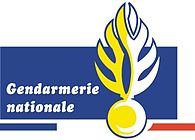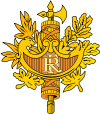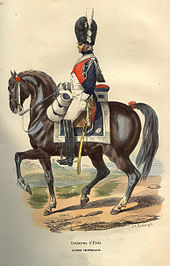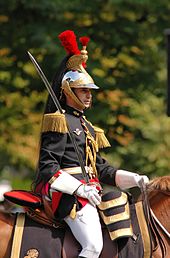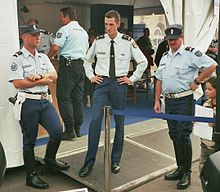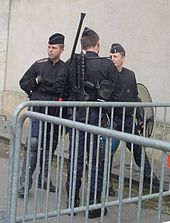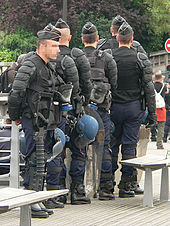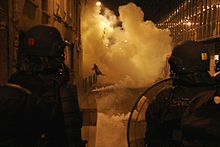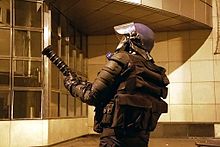- National Gendarmerie
-
- See gendarmerie (disambiguation) for similar forces in other countries.
National Gendarmerie
Gendarmerie nationaleLogo of the National Gendarmerie. Agency overview Formed 1791 Annual budget €7.7 billion Legal personality Governmental: Government agency Jurisdictional structure National agency France Size 674,843 km² Population 66 million General nature Operational structure Headquarters Paris Sworn members 105,975 (in 2007) Agency executive Général d'Armée Jacques Mignaux [1], Directeur-Général Regions 3 Website gendarmerie.interieur.gouv.fr/eng/ In France, the National Gendarmerie (French: Gendarmerie nationale) is a branch of the French Armed Forces, in charge of public safety, with police duties among the civilian population. It also contains a military police force and a special forces component (GIGN). It has a strength of more than 105,975 persons (in 2007).[2] The Gendarmerie works with the other national law enforcement agency, the Police Nationale.
Contents
History
One of the oldest institutions
French Armed Forces Components French Air Force French Army French Navy Gendarmerie Ranks Ranks in the French Army Ranks in the French Navy History of the French Military Military History of France La Grande Armée The Gendarmerie is the direct descendant of the Marshalcy of the ancien regime, more commonly known by its French title, the Maréchaussée.
During the Middle Ages, there were two Grand Officers of the Kingdom of France with police responsibilities: The Marshal of France and the Constable of France. The military policing responsibilities of the Marshal of France were delegated to the Marshal's provost, whose force was known as the Marshalcy because its authority ultimately derived from the Marshal. The marshalcy dates back to the Hundred Years War, and some historians trace it back to the early twelfth century.
Another organisation, the Constabulary (French: Connétablie), was under the command of the Constable of France. The constabulary was regularised as a military body in 1337.
Under King Francis I (French: François 1er, who reigned 1515–1547), the Maréchaussée was merged with the Constabulary. The resulting force was also known as the Maréchaussée, or, formally, the Constabulary and Marshalcy of France (French: connétablie et maréchaussée de France), which unlike the constabulary was not a fully military force.
In 1720, the Maréchaussée was officially attached to the Household of the King (Maison du Roi), together with the "gendarmerie" of the time, which was not a police force at all, but a royal bodyguard. During the eighteenth century, the marshalcy developed in two distinct areas: increasing numbers of Marshalcy Companies (compagnies de marechaussée), dispersed into small detachments, were dotted around the French countryside providing law and order, while specialist units provided security for royal and strategic sites such as palaces and the mint (e.g. the garde de la prévôté de l'hôtel du roi and the prévôté des monnaies de Paris.)
While its existence ensured the relative safety of French rural districts and roads, the Maréchaussée was regarded, in contemporary England (which had no effective police force of any nature), as a symbol of foreign tyranny. In 1789, on the eve of the French Revolution, the Maréchaussée numbered 3,660 men divided into small brigades (a "brigade" in this context being a squad of ten to twenty men.)
The Révolution
During the revolutionary period, marshalcy commanders generally placed themselves under the local constitutional authorities. Despite their connection with the king, they were therefore perceived as a force favouring democratic progress.
As a result, the Maréchaussée, whose title was associated with the king, was not disbanded but simply renamed gendarmerie nationale (Law of 16 February 1791). Its personnel remained unchanged, and the role remained much as it was. However, from this point, the gendarmerie, unlike the marshalcy, was a fully military force. During the revolutionary period, the main force responsible for policing was the National Guard. Although the marshalcy had been the main police force of the ancien regime, the gendarmerie was initially a full-time auxiliary to the National Guard militia.
In 1791 the newly named gendarmerie nationale was grouped into 28 divisions, each commanded by a colonel responsible for three départements. In turn, two companies of gendarmes under the command of captains were based in each department. This territorial basis of organisation continued throughout the 19th and 20th centuries.
Nineteenth century
Under Napoléon, the numbers and responsibilities of the gendarmerie, renamed gendarmerie impériale, were significantly expanded. In contrast to the mounted Maréchaussée, the gendarmerie comprised both horse and foot personnel; in 1800 these numbered approximately 10,500 of the former and 4,500, respectively.
In 1804 the first Inspector General of Gendarmerie was appointed and a general staff established - based in the rue du Faubourg-Saint-Honore in Paris. Subsequently special gendarmerie units were created within the Imperial Guard, and for combat duties in French occupied Spain.
Following the Second Restoration of 1815, the gendarmerie was reduced in numbers to about 18,000 and reorganised into departmental legions. Under King Louis Phillippe a "gendarmerie of Africa" was created for service in Algeria and during the Second Empire the Imperial Guard Gendarmerie Regiment was re-established. The majority of gendarmes continued in what was now the established role of the corps - serving in small sedentary detachments as armed rural police. Under the Third Republic the ratio of foot to mounted gendarmes was increased and the numbers directly incorporated in the French Army with a military police role reduced.[3]
In 1901, the École des officiers de la gendarmerie nationale was established to train its officers.
Battle honours
Five battles are registered on the flag of the Gendarmerie:
- Battle of Hondschoote (1793): Four hundred gendarmes of the 32rd Division engaged in battle on the left wing of the army. They seized enemy artillery positions and lost 117 men.
- Villodrigo (1812): The 1st legion of Gendarmerie on horseback, belonging to the Brigade of Cavalry of the Army of the North, clashed with the British cavalry on 23 October 1812. Charging with sabres, they penetrated enemy lines, killing 250 and taking 85 prisoners. Colonel Béteille, commanding the brigade, received twelve sabre cuts, but he survived.
- Taguin (1843): Thirty gendarmes on horseback were mobilised to take part in tracking the tribe of the emir Abd-El-Kader and participated in his capture. In a painting by Vernet, which immortalises the scene (and hangs in the Musée de Versailles), the gendarmes appear alongside the Algerian Governor-General, Henri d'Orléans, duc d'Aumale.
- Sevastopol (1855): Two infantry battalions of the Regiment of Gendarmerie of the Imperial Guard participated in taking the city. The 1st battalion seized a strategic position that contributed towards the final victory. A total of 153 Gendarmes fell.
- Indo-China (1945/1954): Three legions of infantrymen from the Republican Guard were formed at the end of 1946. Charged with the formation of the Cochin China Civil Guard, they assumed security roles and patrolled the borders, suffering heavy losses: 654 killed or missing, and 1,500 wounded.
The gendarmerie is sometimes referred to as the maréchaussée (an old name for the service), and the gendarmes as pandores. The symbol of the gendarmerie is a grenade, which is also worn by the Italian Carabinieri and the Grenadier Guards in Britain. The budget in 2008 was approximately 7.7 billion euros.[4]
Missions
Its missions include:
- The policing of the countryside, rivers, coastal areas, and small towns with populations under 20,000, that are outside of the jurisdiction of the French National Police. The Gendarmerie provides policing for approximately half of the population of France;
- Criminal investigations under judiciary supervision;
- Crowd control and other security activities;
- The security of airports and military installations, as well as all investigations relating to the military, including foreign interventions;
- Participation in ceremonies involving foreign heads of state or heads of government; and
- Provision of military police services to the French military.
To fulfill the tasks pertaining to internal security, the Minister of the Interior, Internal Security and Local Rights is responsible for the use of the services of the National Gendarmerie. "To this end and in relation with the Minister of Defence, the Minister outlines the duties of the Gendarmerie services, save for the tasks related to criminal investigation, determines the conditions of fulfillment of these duties and the resulting terms of organisation" (decree dated 15 May 2002).[1]
Organisation
Chain of command
While administratively a part of the French armed forces, and therefore under the purview of the Ministry of Defence, the Gendarmerie is operationally attached to the Ministry of the Interior for its operations within France, and criminal investigations are run under the supervision of prosecutors or investigating magistrates. Its members generally operate in uniform, and, only occasionally, in plainclothes.
Role
In 2002, in accordance with commitments made by Jacques Chirac at the time of his campaign for the 2002 presidential election, the Gendarmerie were attached to the Ministry of the Interior for their duties within France. The gendarmes however retained their military status. The brigades were reorganised and were given a broader sphere of activity. New legislation resulted in a new distribution of Gendarmerie and the police force in France.
Director-General
The Director-general of the Gendarmerie is appointed by the Council of Ministers, with the rank of Général d'Armée. The current Director-General is Général Jacques Mignaux.
Directorate-General
The headquarters of the force, called the Directorate-General of the National Gendarmerie, had been located since 1969 at rue St Didier in the XVI° district of the Paris Metropolis. As it grew, expansion was necessary, and now includes eleven other sites distributed throughout the capital and the outskirts of the city.
The Directorate-General of the national gendarmerie includes: - the general staff, divided into offices and services, - one inspectorate of gendarmerie (IGN), - the inspector-general - three services including/understanding each subdirectorate,
- The Inspectorate of the National Gendarmerie (I.G.N) - responsible for studies, information and control. In particular for:
- the judicial enquiries into gendarme misconduct. - the control and the administrative council of the formations of the gendarmerie as well as the economic analysis of the management led by these same formations. - measurements of prevention and control relating to hygiene, the safety and the working conditions.
- Human Resources Service (S.R.H.) - The general, chief of the service of human resources directs the management of the whole of the personnel of the gendarmerie, as well as the policy of recruitment and training of this personnel.
- Plans and Means Service (S.P.M.) - The controller general, chief of the service of the plans and means, translated into plans and programs budgetary objectives of the gendarmerie.
- Operations and Employment Service (S.O.E.) - The general, chief of the service of the operations and employment, has authority on:
- the subdirectorate of the organisation and the evaluation, - the subdirectorate of the international co-operation, - the subdirectorate of defence and the law and order, - the subdirectorate of public safety and the road safety, - the subdirectorate of the Criminal Investigation Department.
The Directorate-General takes part in the correct operation of the organisation. It works: - for the units of the ground and with their profit (at the regional level, the areas and the legions are the essential interfaces so that the decisions taken in Paris correspond well to the needs felt on the ground) ; - as a body of decision-making aid political for all that concerns the gendarmerie in police headquarters (budget, employment…).
It employs 2991 active soldiers, 423 civilian volunteers and 363 other personnel (2004 Figures).
Departmental Gendarmerie
The Departmental Gendarmerie, or Gendarmerie Départementale, also named «La Blanche»[5] (The White), conducts local policing functions throughout the French territory. Its territorial divisions are based on the administrative divisions of France, particularly the departments from which the Departmental Gendarmerie derives its name.
It is divided into regions (headed by a general, one for each defence zone), themselves divided into legion s (headed by a colonel, one for each of the 26 administrative region), themselves divided into groupements (one for each of the 100 département, thus the name), themselves divided into compagnies (one for each of the 342 arrondissements).
It maintains gendarmerie stations throughout the rural parts of the territory. In addition, it has specialised units:
- Research units, who conduct criminal investigations when their difficulty exceeds the abilities of the territorial units;
- Surveillance and intervention units, reinforce gendarmerie forces in high crime areas;
- Units for prevention of juvenile delinquency;
- Highway patrol
- Mountain units, specialised in search and rescue operations, surveillance and inquiries in mountainous areas.
In addition, the Gendarmerie has an institute (Institut de recherche criminelle de la gendarmerie nationale) specializing in the investigation of crimes by scientific and technological means.
Note that the research units may be called into action by the judiciary even within cities. As an example, the Paris research section of the Gendarmerie was in charge of the investigations into the vote-rigging allegations in the 5th district of Paris (see corruption scandals in the Paris region).
Gendarmes normally operate in uniform. They may operate in plainclothes only for specific missions and with their supervisors' authorisation.
Mobile Gendarmerie
The Mobile Gendarmerie, or Gendarmerie Mobile, also named « La Jaune » (The Yellow), is currently divided into 7 defensive zones (Zone de Défense). These include the FGMI (La Force de Gendarmerie Mobile et d'Iintervention) located around Paris and six other zones (South-West, West, South-East, East, South and North) located throughout the rest of France. As a whole this is composed of 123 squadrons for a total of 17000 men and women.[6][7]
Its main responsibilities are
- crowd and riot control
- security of public buildings
- all policing tasks that require large amounts of personnel (Vigipirate counter-terrorism patrols, searches in the countryside...).
Such units may intervene abroad in varied cases such as a hostage crisis or the support of peacekeeping operations.
The civilian tasks of the gendarmes mobiles are similar to those of the police units known as Compagnies Républicaines de Sécurité (CRS), for which they are often mistaken. Easy ways to distinguish them include:
- the uniform of the CRS is blue, the gendarmes mobiles are clad in black;
- the CRS wear a big red CRS patch; the gendarmes have stylised grenades.
- the helmet of the gendarmes mobiles is blue.
- Specialised units
It has the following specialised units:
- the intervention group of the Gendarmerie nationale (GIGN). By 2007, this new GIGN has been formed from the older GIGN (elite counter-terrorism and hostage rescue unit), the parachutist squadron of the Gendarmerie nationale (EPIGN) and the detachment to the security group of the President of the French Republic, whose responsibility was to ensure the safety of the President and of his family and guests. This new unit incorporates all the tasks of these units which were, then part, of the now defunct security and intervention group of the Gendarmerie nationale (GSIGN).[8]
- the GBGM (Groupement Blindé de la Gendarmerie Nationale)Armoured which is part of the FGMI. It is composed of 8 Squadrons (out of the 19 composing the FGMI) equipped with VXB armoured personnel carriers, better know in the Gendarmerie as VBRG(Véhicule Blindé de Reconnaissance de la Gendarmerie, "Gendarmerie reconnaissance armoured vehicle"). It is based at Versailles-Satory. In the past this unit had been equipped with AMX-VCI, Panhard AML and VBC-90 heavy armoured cars with 90 mm cannons. Its current equipment is already aging and it has been in the intention of the French government to replace it but this has been postponed [9].
Special divisions
Republican Guard
Main article: Republican GuardThe Republican Guard is a ceremonial unit based in Paris. Their missions include:[10]
- Guarding important public buildings in Paris such as the Élysée Palace, the residence of the Prime Minister of France, Hôtel Matignon, the Senate, the National Assembly, the Hall of Justice, and keeping public order in Paris.
- Honour and security services for the highest national personalities and important foreign guests;
- Support of other law enforcement forces (with intervention groups, or horseback patrols);
- Staffing horseback patrol stations, particularly for the forests of the Île-de-France region;
- Transporting and escorting urgent organ transplants.
Maritime Gendarmerie
Main article: Maritime GendarmeriePlaced under the dual supervision of the Gendarmerie and the Navy, its missions include:[10]
- police and security in the naval bases;
- maritime surveillance;
- police at sea;
- assistance and rescue at sea.
Air Transport Gendarmerie
Main article: Air Transport GendarmerieThe Air Transport Gendarmerie (Gendarmerie des Transports Aériens) is placed under the dual supervision of the Gendarmerie and the direction of civilian aviation of the transportation ministry, its missions include:[10]
- police and security in civilian airfields and airports;
- filtering access to aircraft, counter-terrorism and counter-narcotic activities, freight surveillance;
- surveillance of technical installations of the airports (control tower...);
- traffic control on the roads within the airports;
- protection of important visitors stopping for a layover;
- judiciary inquiries pertaining to accidents of civilian aircraft.
Air Gendarmerie
Main article: Gendarmerie de l'AirThe Air Gendarmerie (Gendarmerie de l'Air) is placed under the dual supervision of the Gendarmerie and the Air Force, it fulfills police and security missions in the air bases, and goes on the site of an accident involving military aircraft.[10]
Ordnance Gendarmerie
The Ordnance Gendarmerie (Gendarmerie de l'Armement) fulfills police and security missions in the establishments of the Délégation Générale pour l'Armement (France's defence procurement agency).[10]
Overseas Gendarmeries
The non-metropolitan branches include units serving in the French overseas départements and territories (such as the Gendarmerie of Saint-Pierre and Miquelon), staff at the disposal of independent States for technical co-operation, provost detachments in French bases located in some independent States, Germany, security guards in French embassies and consulates abroad.
Foreign Service
They have also served in:
- Lebanon
- Algeria
- Kosovo
- Rwanda
- Côte d'Ivoire
- Bosnia-Herzegovina
- Haiti
- Central Africa
- Republic of Macedonia
- Afghanistan
Ranks
Officiers Généraux (General Officers)
Grade (Rank) Insigna Rank Général d'Armée
(Army General)Général de Corps d'Armée
(Corps General)Général de Division
(Divisional General)Général de Brigade
(Brigade General)Officiers supérieurs (Senior Officers)
Grade
(Rank)Insigna Rank
DépartementaleInsigna Rank
MobileCorps administratif
et techniqueInsigna Rank
Garde républicaineColonel
(Colonel)Lieutenant-Colonel
(Lieutenant Colonel)Chef d'Escadron
(Squadron Leader)
(Major)Officiers Subalternes (Junior Officers)
Grade
(Rank)Insigna Rank
DépartementaleInsigna Rank
MobileCorps administratif
et techniqueInsigna Rank
Garde républicaineCapitaine
(Captain)Lieutenant
(Lieutenant)Sous-Lieutenant
(Sub-Lieutenant)
(Second Lieutenant)Aspirant
(Aspirant)Élève Officier
(Officer Cadet)Sous-officiers (Sub-Officers)
Grade
(Rank)Insigna Rank
DépartementaleInsigna Rank
MobileInsigna Rank
Corps de soutienInsigna Rank
Garde républicaineMajor
(Major)
(Sergeant Major)Adjudant-Chef
(Chief Adjutant)
(Warrant Officer Class One)Adjudant
(Adjutant)
(Warrant Officer Class Two)Maréchal des Logis-Chef
(Chief Marshal of Lodgings)
(Staff Sergeant)Gendarme
(Gendarme)
(Sergeant)Gendarme Réserviste
(Reservist Gendarme)Élève Sous-officiers
(Sub-Officer Cadet)Gendarmes du Rang (Gendarmes of the Ranks)
These lowest ranks are rare since the suspension of conscription.
Grade
(Rank)Insigna Rank
Départementale & MobileGendarme Adjoint Maréchal-des-logis
(Deputy Gendarme Marshal of Lodgings)
(Sergeant)Gendarme Adjoint Brigadier Chef
(Deputy Gendarme Chief-Brigadier)
(Corporal)Gendarme Adjoint Brigadier
(Deputy Gendarme Brigadier)
(Lance Corporal)Gendarme Adjoint 1ère Classe
(Deputy Gendarme First Class)Gendarme Adjoint
(Deputy Gendarme)Manpower
The National Gendarmerie consisted of 105,389 personnel units by 31 December 2006. Career gendarmes are either commissioned or non-commissioned officers. The lower ranks consist of auxiliary gendarmes on limited-time/term contracts. The 103,481 military personnel of the National Gendarmerie is divided into:[11]
- 5789 officers and 78354 NCOs of gendarmerie;
- 237 officers and 3,824 NCOs of the technical and administrative body;
- 15,277 section volunteers, from voluntary gendarmes (AGIV) and voluntary assistant gendarmes (GAV);
- 1,908 civilian personnel are divided into civil servants, state workers and contracted workers;
- 40,000 reserve personnel. This reserve force had not yet reached the authorised size limit. Only 25,000 men and women were signed up for reserve engagements (E.S.R.).[2]
This personnel mans the following units:
Departemental Gendarmerie:
- 1,055 Community brigades;
- 697 autonomous brigades ;
- 370 Surveillance and Intervention Platoons (PSIG);
- 271 Dog-handling Teams;
- 17 Mountain Platoons;
- 92 Departmental Brigades for Investigations and Judicial Services;
- 383 Research sections and brigades;
- 14 Air Sections;
- 7 River Brigades;
- 26 Coastal brigades;
- 93 departmental squadrons for roadway security;
- 136 Highway Platoons;
- 37 brigades for the prevention of juvenile delinquency;
- 21 Centers for Information and Recruitment.
Gendarmerie Mobile : 123 squadrons
- 6 Special Security Platoons.
Special Formations:
- 5 squadrons and 10 companies of Republican Guard;
- 40 brigades of gendarmerie for air transports and research sections (BGTA);
- 8 Protection Units;
- 19 Air sections and detachments;
- 18 gendarmerie armament units.
Other units :
- 3 673 personnel overseas posts;
- 74 brigades and postes of the maritime gendarmerie;
- 54 brigades of Air Gendarmerie;
- 23 schools and Instruction Centers.[2]
Prospective Centre
The Gendarmerie nationale's Prospective Centre (CPGN), which was created in 1998 by an ordinance of the Minister for Defence, is one of the gendarmerie's answers to officials' willingness to the modernise the State. Under the direct authority of the general director of the gendarmerie, it is located in Penthièvre barracks on avenue Delcassé in Paris and managed by Mr Frédéric LENICA, (assisted by a general secretary, Colonel LAPPRAND) "maître des requêtes" in the Conseil d'Etat.[12]
Some notes
- ^ La gendarmerie nie l'illégalité du fichier sur les Roms
- ^ a b c http://www.defense.gouv.fr/gendarmerie/decouverte/moyens/effectifs/repartition/repartition_des_effectifs
- ^ Edouard Detaille, pages 281-293, "L'Armee Francaise", ISBN0-9632558-0-0
- ^ 2008 Budget Bill, French Senate
- ^ After the colour of the silver stripes that the gendarmes wear on their kepis, as opposed to the golden striped of the Mobile Gendarmerie.
- ^ http://www.recrutement.gendarmerie.defense.gouv.fr/contenu/decouvrir/securite_publique/gendarme_mobile__1
- ^ les escadrons des Zone de Défense
- ^ Accueil
- ^ Projet de loi de finances pour 2011 : Sécurité : Gendarmerie nationale
- ^ a b c d e http://www.defense.gouv.fr/gendarmerie/votre_espace/contents_in_english/organisation/special_branches/special_branches
- ^ http://www.defense.gouv.fr/gendarmerie/votre_espace/contents_in_english/personnel/personnel
- ^ http://www.defense.gouv.fr/gendarmerie/votre_espace/contents_in_english/gendarmerie_nationale_s_prospective_centre_cpgn/gendarmerie_nationale_s_prospective_centre_cpgn
- In 2005, the Gendarmerie announced that is was switching its 70,000 personal computers from Microsoft Office (or Microsoft Word) to the OpenOffice.org suite. In 2006, they began switching web browsers from Internet Explorer to Mozilla Firefox and email clients to Mozilla Thunderbird. According to General Brachet, GN Chief of Communications and Computing Systems, the goal is to move all applications to fully standardised protocols and formats, so that they are platform-neutral.
See also
- Law enforcement in France
- Police
- Gendarmerie
- Le gendarme de Saint-Tropez - cult comedy series
- Marechaussee
External links
- Gendarmerie nationale official site
- Gendarmerie nationale official site (French)
- Gendarmerie nationale site at the French MoD (French)
Categories:- National law enforcement agencies of France
- Gendarmerie
- French Gendarmerie
- Military of France
Wikimedia Foundation. 2010.

